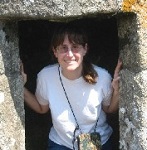The ‘Nifty Fifty (times 4)’, a program of Science Spark, presented by InfoComm International, are a group of 200 noted science and engineering professionals who will fan out across the Washington, D.C. area in the 2014-2015 school year to speak about their work and careers at various middle and high schools.
Meet Nifty Fifty Speaker Dr. Erica Ellingson
 Her research is key to shedding further light on how the cosmos began and its future development.
Her research is key to shedding further light on how the cosmos began and its future development.
"My work focuses mostly on topics concerning the evolution of galaxies and quasars, and observational cosmology-- the origin, contents and evolution of the universe,¨ says Erica, Professor of Astrophysics and Planetary Sciences at the University of Colorado, Boulder.
¨Much of my recent research concerns clusters of galaxies-- giant structures of hundreds or thousands of galaxies and clouds of hot gas, held together by the gravity of invisible dark matter.¨
In this realm, she is investigating such important questions as: how much dark matter is in clusters, how do clusters grow and evolve over time within the expanding universe, and ¨how does the environment of the galaxy cluster affect the unfortunate galaxies which fall into it.¨
Erica's research is cosmic, especially when you also consider that galaxy clusters are the largest gravitationally-bound objects in the universe-- the great whales of the starry deep. Although they contain hundreds of galaxies, and tremendous amounts of gas, their gigantic masses are dominated by mysterious dark matter. As the densest intersections in the cosmic web, galaxy clusters can help map the patterns of cosmic structure, and provide important clues about dark matter and the even-more-elusive dark energy.
Says Erica: "I love looking at the universe, and in my work I use a variety of different types of telescope for research including large and small ground-based telescopes from around the world, the Hubble Space Telescope, the Spitzer Infrared Telescope, and the Chandra and XMM-Newton X-Ray space telescopes."
The author of more than 100 refereed articles in professional publications and a regular invited speaker at international conferences in astrophysics, Erica is also widely known for her passion to bring the excitement of planetary science to the public and students in exciting ways. At the University of Colorado-Boulder's Fiske Planetarium, she has written and produced shows for the public on galaxies, cosmology and the history of science. She also teaches many of her astronomy course classes on campus, at the Sommers-Bausch Observatory.
In 2011, Dr. Ellingson initiated a program whose aim is to support minority, first generation and rural students who are physical science majors. CU STARS (Science, Technology and Astronomy Recruits) offers internships, peer mentoring and academic support to students in their first years of university. She also leads an outreach program where these students return to their former high schools and underserved schools in both urban and rural Colorado, where the students lead classes on science topics and their own paths to becoming scientists.
She is the co-author of a children's book, "Max Goes to Jupiter," which was chosen to be read aloud on the International Space Station for NASA's "Story Time from Space" program.
Erica earned her Bachelor's of Science degree in Physics from MIT, and her Ph.D. in Astronomy from the University of Arizona, followed by postdoctoral fellowships at the Dominion Astrophysical Observatory, Victoria, BC and at the University of Colorado.
Click here for more information.